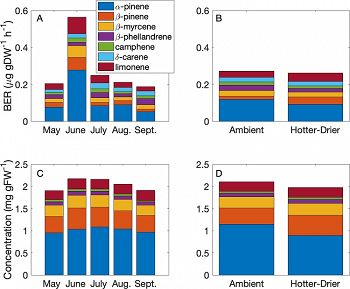Trowbridge et al., 2019
Drought supersedes warming in determining volatile and tissue defenses of piñon pine (Pinus edulis)
Trowbridge A.M., Stoy P.C., Adams H.D., Law D.J., Breshears D.D., Helmig D., and Monson R.K. (2019)
Environmental Research Letters 14(6): 065006
-
Catalina-Jemez, INVESTIGATOR, COLLABORATOR
-
Catalina-Jemez, INVESTIGATOR
Abstract
Average monoterpene basal emission rates (BER) by month (A) and by site (B) and needle monoterpene concentrations by month (C) and site (D) from piñon pine transplanted near the original piñon-juniper woodland (Ambient), and transplanted to a hotter and drier site (Hotter-Drier) in northern Arizona, USA
Trees are suffering mortality across the globe as a result of drought, warming, and biotic attacks. The combined effects of warming and drought on in situ tree chemical defenses against herbivory have not been studied to date. To address this, we transplanted mature piñon pine trees—a well-studied species that has undergone extensive drought and herbivore-related mortality—within their native woodland habitat and also to a hotter-drier habitat and measured monoterpene emissions and concentrations across the growing season. We hypothesized that greater needle temperatures in the hotter-drier site would increase monoterpene emission rates and consequently lower needle monoterpene concentrations, and that this temperature effect would dominate the seasonal pattern of monoterpene concentrations regardless of drought. In support of our hypothesis, needle monoterpene concentrations were lower across all seasons in trees transplanted to the hotter-drier site. Contrary to our hypothesis, basal emission rates (emission rates normalized to 30 °C and a radiative flux of 1000 μmol m−2 s−1) did not differ between sites. This is because an increase in emissions at the hotter-drier site from a 1.5 °C average temperature increase was offset by decreased emissions from greater plant water stress. High emission rates were frequently observed during June, which were not related to plant physiological or environmental factors but did not occur below pre-dawn leaf water potentials of −2 MPa, the approximate zero carbon assimilation point in piñon pine. Emission rates were also not under environmental or plant physiological control when pre-dawn leaf water potential was less than −2 MPa. Our results suggest that drought may override the effects of temperature on monoterpene emissions and tissue concentrations, and that the influence of drought may occur through metabolic processes sensitive to the overall needle carbon balance.
Citation
Trowbridge A.M., Stoy P.C., Adams H.D., Law D.J., Breshears D.D., Helmig D., and Monson R.K. (2019): Drought supersedes warming in determining volatile and tissue defenses of piñon pine (Pinus edulis). Environmental Research Letters 14(6): 065006. DOI: 10.1088/1748-9326/ab1493
 This Paper/Book acknowledges NSF CZO grant support.
This Paper/Book acknowledges NSF CZO grant support.
Explore Further



